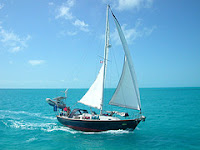SHoGUN (hull 51) is for sale
Please visit the Cabot Documents site to see full information on the boat.
A site to celebrate this great Canadian passage maker.

Thomas Groeneveld (JULY 27/07)
This is Tom Groeneveld on Morning Light II , hull 29, in Curacao. Just put the boat on the hard and discovered a few blisters, maybe a dozen. Had many more 2 years ago and even more 4 years ago.
Ground them out, let them dry and filled with epoxy and silica. Am amazed that the hull is in such good shape. Put a few holes in the rudder but hardly any fluid coming out.
All is well and I will keep on sailing the Cabot.
Scott Schloesser here, hull 32 ( Cimba C36-32 )
I haven't dealt with it yet but Cimba has about 100 blisters in the range from 1" about 80 to 2" about 20 probably from the time it spent down in the islands , plus the rudder core is wet , trying to schedule for a fall haul out.
Bob Ciupa (Hull #50) July 28/07
I did my bottom for osmosis, voids, and barrier coat the hard way during the winter and spring of 05-06. Fell free to have Jan get hold of me, I have loads of info I'd be happy to share.
P.S. If I ever get my hard dodger finished, I'll send you some pics of the boat and info regarding a name change.
Roy Mac Keen (July 29/07)
I would be surprised if 'osmosis' was not a problem with the Cabot, but up until the closing of the factory, we had no indication of the problem. As you are aware osmosis is the penetration through differential pressure of moisture through the gel coat. In the days of the Cabot, gel coat was resin thickened with calcium carbonate ( highly porous) with the addition of colour.
There really is only one way to defeat it: Peel, dry, and barrier coat .
Banff Luther, Sailbluemagic (Hull 33) email July 31/07